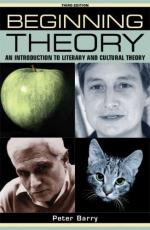
|
| Name: _________________________ | Period: ___________________ |
This test consists of 5 multiple choice questions, 5 short answer questions, and 10 short essay questions.
Multiple Choice Questions
1. What term suggests a range of negative attributes, such as "non-Marxist" and "non-feminist," and "non-theoretical"?
(a) Dialogism.
(b) Modernism.
(c) Humanism.
(d) Absurdism.
2. Which of the following works of T.S. Eliot was a collage of juxtaposed, incomplete stories, or fragments of stories according to the chapter titled "Postmodernism"?
(a) Prufrock and Other Observations.
(b) The Waste Land.
(c) The Use of Poetry and the Use of Criticism.
(d) Essays Ancient and Modern.
3. According to Peter Barry, the ________ aspect of discourse is characterized not by logic and order, but by "displacement, slippage, condensation."
(a) Imaginary.
(b) Symbolic.
(c) Semiotic.
(d) Natural.
4. The chapter "Feminist Criticism" suggests that feminist criticism became much more ________, meaning that it began to draw upon the findings and approaches of other kinds of criticism.
(a) Rhetoric.
(b) Trope.
(c) Eclectic.
(d) Perlocutionary.
5. Author Peter Barry informs the reader that the feminist literary criticism of today was the direct product of the "women's movement" of the ________.
(a) 1930s.
(b) 1980s.
(c) 1910s.
(d) 1960s.
Short Answer Questions
1. In the chapter titled "Feminist Criticism," which group did author Peter Barry say maintained a major interest in traditional critical concepts like theme, motif, and characterization?
2. The chapter titled "Psychoanalytic Criticism" discusses the use by the unconscious of these linguistic means of self-expression is part of ________'s evidence for the claim that the unconscious is structured like a language.
3. Who was the first critic to develop a "reader-centered" approach to literature?
4. In the Introduction, what university did author Peter Barry say he attended?
5. What language does the narrator describe as being a Romance language that takes most of its words directly from Latin, and lacks the reassuring Anglo-Saxon layer of vocabulary?
Short Essay Questions
1. Compare post-colonialism to postmodernism as discussed in the chapter "Theory Before Theory--Liberal Humanism."
2. What is structuralism? Where and when did it begin?
3. Do liberal humanists use the term "human nature"? Explain.
4. Why was Freudian interpretation interesting to literary critics?
5. Discuss how J.A. Cuddon describes postmodernism in his "Dictionary of Literary Terms and Literary Theory."
6. Briefly summarize author Peter Barry's own introduction to literary theory as seen in "My own stock-taking" found within the "Introduction."
7. In the first half of the twentieth century, who, according to Barry, were the critical names in British literary theory? Who were at Cambridge University in the 1920s and 1930s?
8. Who was Jean Baudrillard? How was he associated with "the loss of the real"?
9. Explain F.D. Maurice's opinions of literature as detailed in the chapter "Theory Before Theory--Liberal Humanism."
10. What is "ecriture feminine"?
|
This section contains 820 words (approx. 3 pages at 300 words per page) |

|




